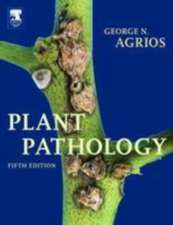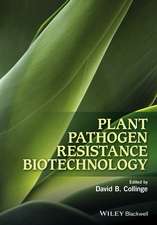Genomics and Molecular Genetics of Plant-Nematode Interactions
Editat de John Jones, Godelieve Gheysen, Carmen Fenollen Limba Engleză Paperback – 21 noi 2014
| Toate formatele și edițiile | Preț | Express |
|---|---|---|
| Paperback (1) | 1829.36 lei 6-8 săpt. | |
| SPRINGER NETHERLANDS – 21 noi 2014 | 1829.36 lei 6-8 săpt. | |
| Hardback (1) | 1828.92 lei 6-8 săpt. | |
| SPRINGER NETHERLANDS – 6 mai 2011 | 1828.92 lei 6-8 săpt. |
Preț: 1829.36 lei
Preț vechi: 2230.94 lei
-18% Nou
Puncte Express: 2744
Preț estimativ în valută:
350.08€ • 363.42$ • 291.92£
350.08€ • 363.42$ • 291.92£
Carte tipărită la comandă
Livrare economică 22 martie-05 aprilie
Preluare comenzi: 021 569.72.76
Specificații
ISBN-13: 9789400797338
ISBN-10: 9400797338
Pagini: 584
Ilustrații: XXIV, 557 p.
Dimensiuni: 155 x 235 x 31 mm
Greutate: 0.81 kg
Ediția:2011
Editura: SPRINGER NETHERLANDS
Colecția Springer
Locul publicării:Dordrecht, Netherlands
ISBN-10: 9400797338
Pagini: 584
Ilustrații: XXIV, 557 p.
Dimensiuni: 155 x 235 x 31 mm
Greutate: 0.81 kg
Ediția:2011
Editura: SPRINGER NETHERLANDS
Colecția Springer
Locul publicării:Dordrecht, Netherlands
Public țintă
ResearchCuprins
Part I – Introductory Chapters. 1. Introduction to Plant-parasitic Nematodes; Modes of Parasitism.- 2. Current nematode threats to world agriculture.- 3. Phylogeny and evolution of nematodes.- 4. Cyst nematodes and syncytia.- 5. Root-knot nematodes and giant cells.- Part II - Resources for functional analysis of plant-nematode interactions.- 6. Genome analysis of plant parasitic nematodes.- 7. Transcriptomes of plant-parasitic nematodes.- 8. Arabidopsis as a tool for the study of plant-nematode interactions.- 9. Transcriptomic and proteomic analysis of the plant response to nematode infection.- 10. C. elegans as a resource for studies on plant parasitic nematodes.- 11. Parallels between plant and animal parasitic nematodes.- 12. Degradation of the plant cell wall by nematodes.- 13. Suppression of plant defences by nematodes.- 14. Other nematode effectors and evolutionary constraints.- 15. Disease resistance-genes and defense responses during incompatible interactions.- 16. The role of plant hormones in nematode feeding cell formation.- 17. Unravelling the plant cell cycle in nematode induced feeding sites.- 18. The plant cytoskeleton remodelling in nematode induced feeding sites.- 19. Cell wall modifications induced by nematodes.- 20. Water and nutrient transport in nematode feeding sites.- Part IV - Applied aspects of molecular plant nematology: exploiting genomics for practical outputs.- 21. Molecular tools for diagnostics.- 22. Breeding for nematode resistance: use of genomic information.- 23. Biological Control of Plant-Parasitic Nematodes: Towards Understanding Field Variation Through Molecular Mechanisms.- 24. Nematode resistant GM crops in industrialised and developing countries.
Recenzii
From the reviews:
“Throughout the volume, the editors have done an outstanding job of placing recent achievements into a historical context. Each chapter provides an extensive list of references, including historic landmark papers and recent publications. … this book provides not only a critical analysis of recent developments in plant-nematode interactions, but also a valuable literature resource for years to come. … I highly recommend this volume not only for specialists who are interested in plant-nematode interactions, but for nematologists and plant pathologists in general.” (Axel A. Elling, The Quarterly Review of Biology, Vol. 87 (3), September, 2012)
“Throughout the volume, the editors have done an outstanding job of placing recent achievements into a historical context. Each chapter provides an extensive list of references, including historic landmark papers and recent publications. … this book provides not only a critical analysis of recent developments in plant-nematode interactions, but also a valuable literature resource for years to come. … I highly recommend this volume not only for specialists who are interested in plant-nematode interactions, but for nematologists and plant pathologists in general.” (Axel A. Elling, The Quarterly Review of Biology, Vol. 87 (3), September, 2012)
Textul de pe ultima copertă
Plant parasitic nematodes often establish unique, sophisticated relationships with their hosts, dramatically influencing plant productivity. This book reviews the most recent developments in the molecular biology of plant-nematode interactions that have been driven by the application of genomics tools. The book will be of interest to postgraduate students and to researchers with an interest in plant nematology and/or plant pathology more generally. A series of introductory chapters provide a biological context for the detailed reviews of all areas of plant-nematode interactions that follow and ensure that the bulk of the book is accessible to the non-specialist. Chapters provide not just the exciting state of the art in each field, but also the experts’ views of how they expect that research in each field would develop in the near future. A final section aims to show how these fundamental studies have provided outputs of practical relevance in agriculture.
Caracteristici
Detailed reviews of many different areas of plant-nematode interactions by leading experts in the fields Coverage of how a wide range of genomics approaches have been applied to plant nematology Links to other areas of plant pathology. 4. Introductory articles make the book accessible to students and other new workers in this area Includes supplementary material: sn.pub/extras




